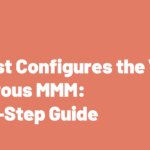With digital tracking breaking and privacy concerns on the rise, more consumer brands are looking for alternatives to multi-touch attribution.
While MTA is still the standard measurement method, especially in the early growth stages, marketing mix modeling is quickly growing in usage across top brands because it only needs aggregate data and therefore doesn’t have any privacy concerns.
MMM is not new, but it has been modernized in recent years, lowering the barriers of entry and making it a more suitable option for more brands – here’s who is using MMM.
Now, if you’re seeing that MTA is less and less effective, and you have your eyes on MMM, know that it’s not an easy transition – we see this on a daily basis at Recast.
There are two key questions: when is the right time to upgrade? And how should we do it?
When to upgrade from MTA to MMM?
Most small ecommerce brands probably don’t need anything more complicated than digital tracking tools for measuring marketing performance.
But when the channel mix gets more complex and your marketing grows, digital tracking is simply not enough and you need to start evaluating other tools. I think it’s a good time to start thinking about running some experiments and “building their testing muscle” once a brand gets to around $100k / month in paid media budget.
In general, we think MMM really only starts to make sense at the $5 – $10 million of paid marketing spend per year. That’s a good time to start thinking about MMM, how much you’re willing to invest in it, and what is the potential payoff of implementing it.
With less spend than $5M per year, it’s just hard to make the project successful given how complicated MMM is and how easy it is to get wrong.
On the way there, the most important thing is for an organization to start talking seriously about incrementality. Start running some experiments, doing testing… The more that you can build that foundation, the more you’re setting yourself up for the success of your future MMM projects.
How to upgrade from MTA to MMM?
If you’re a brand considering getting started with MMM, you need to make sure you’re ready to commit to using an entirely new measurement system.
If you decide to do it, you need to take it really seriously and be ready to invest in making sure that you have a good model with results that you can trust.
We often see brands realize they are having problems with MTA, and so they go run an MMM in an Excel sheet or hire some fly-by-night consultant that doesn’t really know what they’re doing.
The results they get back are, unfortunately, totally wrong. Then one of two things happens:
1. Best case scenario is the marketing team ignores the results and keeps doing what they’ve been doing.
2. Worse scenario is the marketing team actually starts to use the results and wastes a bunch of marketing spend on channels that don’t actually work.
MMM can work. But you have to do it right because a bad MMM is worse than no MMM.
Doing MMM well requires expert resources and, most importantly, a strategy for validating the incrementality estimates coming out of the MMM. Just running an algorithm and taking whatever numbers pop out the other side is a recipe for disaster.
At Recast, we spend a lot of time thinking about not just the assumptions that should go into an MMM, but also how we validate that the results are actually correct.
And here’s the thing: even if you do the modeling correctly, if your organization isn’t prepared to understand the results and how to use them, it won’t work.
You need to make sure your business is thinking about incrementality and understands the drawbacks of digital tracking so that, once it’s time to do sophisticated MMM, everyone understands why you’re embarking on that journey and what to do with the information.
How do we get these methods working together?
None of the measurement methods –MTA, MMM and conversion lift studies– are perfect. They all have pros and cons, and they all give you a different view. It’s your job as a modern marketer to bring all of them to get closer to the truth of your performance. We call this triangulation.
Incrementality is the ultimate goal here: how many of your sales wouldn’t have happened had you not invested in marketing? And it is easier to find it through triangulation than if you use one of the methods in silo.
We hope it’s clear that the goal of this article is not to convince brands to drop MTA – it still has a time and place where it can be useful. But to show you how and when to add MMM to your measurement mix so you can triangulate and get a more accurate picture that helps your budget allocation decisions.
If you’d like to see if Recast is right for your brand, let’s chat.



